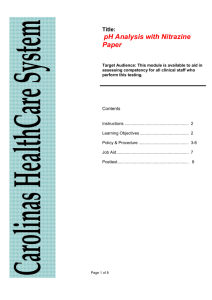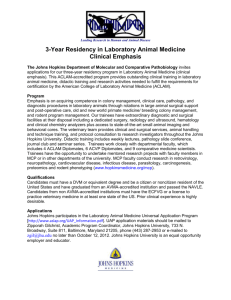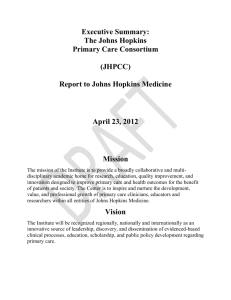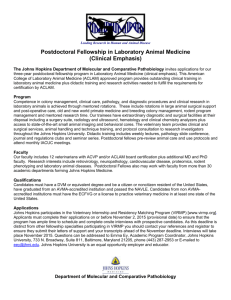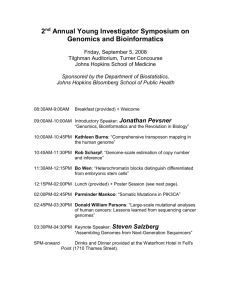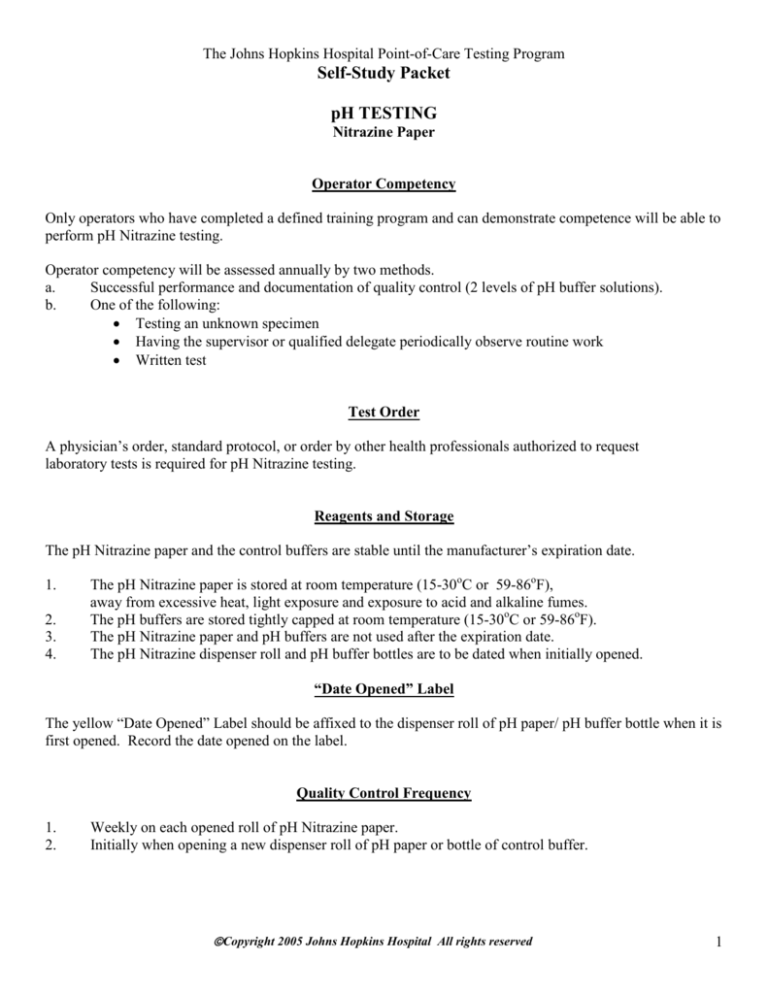
The Johns Hopkins Hospital Point-of-Care Testing Program
Self-Study Packet
pH TESTING
Nitrazine Paper
Operator Competency
Only operators who have completed a defined training program and can demonstrate competence will be able to
perform pH Nitrazine testing.
Operator competency will be assessed annually by two methods.
a.
Successful performance and documentation of quality control (2 levels of pH buffer solutions).
b.
One of the following:
• Testing an unknown specimen
• Having the supervisor or qualified delegate periodically observe routine work
• Written test
Test Order
A physician’s order, standard protocol, or order by other health professionals authorized to request
laboratory tests is required for pH Nitrazine testing.
Reagents and Storage
The pH Nitrazine paper and the control buffers are stable until the manufacturer’s expiration date.
1.
2.
3.
4.
The pH Nitrazine paper is stored at room temperature (15-30oC or 59-86oF),
away from excessive heat, light exposure and exposure to acid and alkaline fumes.
The pH buffers are stored tightly capped at room temperature (15-30oC or 59-86oF).
The pH Nitrazine paper and pH buffers are not used after the expiration date.
The pH Nitrazine dispenser roll and pH buffer bottles are to be dated when initially opened.
“Date Opened” Label
The yellow “Date Opened” Label should be affixed to the dispenser roll of pH paper/ pH buffer bottle when it is
first opened. Record the date opened on the label.
Quality Control Frequency
1.
2.
Weekly on each opened roll of pH Nitrazine paper.
Initially when opening a new dispenser roll of pH paper or bottle of control buffer.
Copyright 2005 Johns Hopkins Hospital All rights reserved
1
The Johns Hopkins Hospital POCT Program
Self-Study Packet
pH Nitrazine
Quality Control Procedure
1.
2.
3.
4.
5.
6.
7.
Record the lot numbers and expiration dates of the pH Nitrazine paper and control buffer solutions
on the pH Nitrazine QC Log Sheet, along with the date, time and operator initials.
Wearing gloves, tear off a strip of Nitrazine paper from the roll
Dispense a drop of the pH 5.0 buffer solution onto the strip of pH paper.
Immediately match the color of the pH paper with the closest color on the Color Chart supplied with the
Nitrazine paper dispenser. NOTE: Colors are unstable and results should be read within 60 seconds.
Record the actual number value of the pH test result on the QC log sheet.
Repeat steps 2-5 with the pH 7.0 buffer solution.
Discard used pH paper into a JHMI-approved biohazard waste container.
Quality Control – Results Documentation Summary
1.
2.
3.
4.
5.
Record date, time, operator initials, lot numbers and expiration dates of pH Nitrazine paper and control
buffer solutions on the pH Nitrazine QC Log Sheet.
Record the pH results as actual numbers.
Verify that all of the QC buffer results are within acceptable range by comparing the results obtained to
the control ranges posted on the pH Nitrazine QC Log Sheet.
Place a check mark (√) in the QC Pass/Fail box on the QC Log Sheet to note whether QC passed or
failed.
Document any QC failures and corrective actions in the Comment Section of the pH Nitrazine
QC Log Sheet.
Quality Control Failures and Corrective Actions
If the QC results fail, i.e., the expected results are not obtained:
1.
2.
3.
4.
5.
6.
7.
8.
Check to make sure that the Nitrazine paper and pH buffers have not expired.
Repeat the test.
If repeat test fails, open a new bottle of pH buffer solution and repeat test.
If the test fails with the new buffers, open and date a new roll of Nitrazine paper.
Repeat the test.
If the repeat test with new buffers and Nitrazine paper fails, DO NOT PERFORM ANY PATIENT
TESTING until the quality control issues are resolved and the expected results are obtained and
recorded.
Document all steps taken in the Comment Section of the pH Nitrazine QC Log Sheet.
Contact the POCT Program Office for assistance.
Copyright 2005 Johns Hopkins Hospital All rights reserved
2
The Johns Hopkins Hospital POCT Program
Self-Study Packet
pH Nitrazine
Specimen Collection
1.
2.
3.
4.
Use at least 2 unique patient identifiers (neither to be the patient’s room number) to verify a
patient’s identity when collecting samples for testing.
The pH Nitrazine test is used to determine the pH of vaginal, nasal, ocular and salivary secretions.
Samples must be fresh (not refrigerated) and tested promptly.
Gloves must be worn during sample collection and testing (Standard Precautions)
Patient Testing
1.
2.
3.
4.
5.
6.
7.
8.
9
10.
Check the pH Nitrazine QC Log Sheet to make sure that quality control has been performed for the
week. If not, perform QC.
Check the expiration date of the pH Nitrazine paper.
Wearing gloves, tear off a strip of Nitrazine pH paper from the roll.
Bring the strip of Nitrazine paper into contact with the specimen, either by dipping the paper into the
pool of suspected amniotic fluid or by touching the paper to the exam speculum.
Within 60 seconds, match the color of the Nitrazine pH paper to the closest color on the Color Chart
supplied with the pH paper dispenser.
Record the actual pH number value on the dated, timed, and initialed progress note in the patient chart.
Place a check mark (√) or “QC okay” next to the patient result to indicate that the pH quality control had
been run within one week.
Note result as a Point-of-Care result in order to differentiate this result from a central laboratory result.
Document any problems encountered with the test in the comment section of the pH Nitrazine QC Log
Sheet.
Discard the used pH paper into a JHMI-approved biohazard waste container.
Result Interpretation
VAGINAL FLUID: Strip Color
Yellow
Olive Yellow
Light Olive Green
Dark Olive Green
AMNIOTIC FLUID: Strip Color
Blue Green
Blue
Deep Blue
pH VALUE
pH 4.5
pH 5.0
pH 5.5
pH 6.0
pH VALUE
pH 6.5
pH 7.0
pH 7.5
Copyright 2005 Johns Hopkins Hospital All rights reserved
3
The Johns Hopkins Hospital POCT Program
Self-Study Packet
pH Nitrazine
Reference Ranges
Vaginal pH:
Amniotic Fluid:
3.8 – 4.2
7.0 – 7.5
Interferences
Interferences for the Nitrazine pH test include:
●
●
●
Salt solutions and enzymes may cause deviations in Nitrazine pH results
False positives may be seen in the presence of:
a.
Soap
b.
A rise in pH due to infections such as trichomoniasis or bacterial vaginosis
c.
Blood, semen, cervical mucous
False negatives may be seen with:
a.
Too little fluid analyzed
b.
Prolonged leaking of fluid
Limitations
1. Nitrazine paper is not to be used for pH determinations of urine and/or gastric fluid.
2. The accuracy of Nitrazine paper is affected by salts, proteins, and other factors. Deviations may, under
certain conditions, exceed 0.5 pH units.
3. Do not touch the pH paper with bare fingers.
4. The color of undeveloped Nitrazine paper may vary from light yellow to an olive green color. Color
variation does not affect the paper’s response to pH changes.
5. Avoid color comparison under fluorescent lights alone.
6. Use only the Color Chart included with each specific package of Nitrazine pH paper. If the chart is
missing, discard the roll and open/date a new roll of Nitrazine pH paper.
Revision: 11/2010
Copyright 2005 Johns Hopkins Hospital All rights reserved
4



